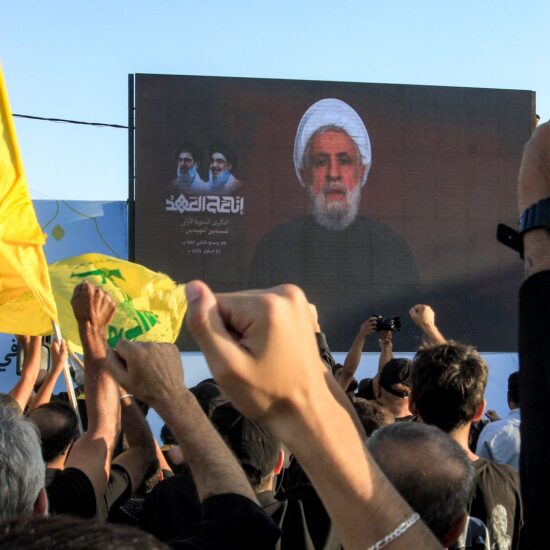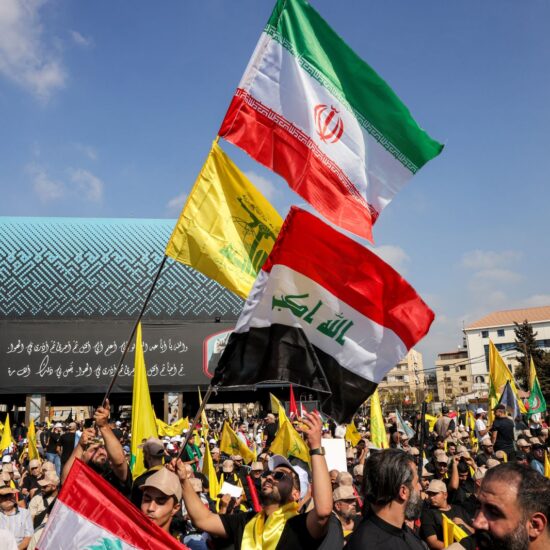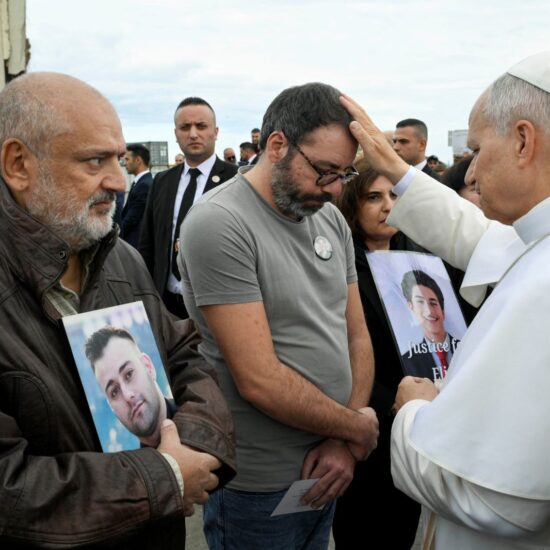
On Hezbollah’s military arsenal, the disarmament efforts of Nawaf Salam’s government, and the shadows of a possible interference of the Israeli intelligence: what will be the future of the ‘Party of God’?
It seemed that a formal ceasefire and the election of another President of the Republic would have been enough to return to imagining Lebanon as a united country: as a nation. But the age-old dispute between communities – political rather than religious, between their symbols, their ambitions, their alliances – has once again returned to prove that, until we can agree on which the occupying enemy is and what are the appropriate means to confront it, not only liberation – but the imagination of that liberation – will remain no more than a rhetorical, insubstantial quirk, to be celebrated every May 25.
Two events, in the space of a few days, have – if not shocked – at least uncovered some of the cards on the table of Baabda’s agenda. Last Saturday, amidst the rubble left by Israeli bombardment of south Lebanon, campaign posters urged support for Hezbollah in municipal elections as the group aimed to show it retains political clout despite the pounding it took in last year’s war: for the ‘Party of God’, in fact, the local vote was more important than ever, coinciding with mounting calls for its disarmament and continued Israeli airstrikes, and as many of its constituents are still suffering the repercussions of the ongoing conflict.
Then, on Monday, five months after Joseph Aoun’s election – which was surprisingly not obstructed by the Shiite MPs, who indeed agreed to a significant political compromise -, the President met with a Hezbollah delegation to discuss the issue of the state’s monopoly of weapons: one of the first points touched by the former LAF commander after his inception in the presidential palace. The meeting was originally meant to be a formal occasion to ‘congratulate’ Aoun on the anniversary of the 2000 liberation, which paradoxically enough came about largely through the armed action of the Party of God, as well as the conclusion of the municipal elections. Yet it turned into an opportunity to address, for the first time directly, the question of Hezbollah’s disarmament – even north of the Litani River – which the President committed to tackling through a bilateral dialogue with the Shiite party.
In the November 2024 ceasefire that ended the Hezbollah-Israel war, in fact, the Lebanese government agreed to implement UN Security Council Resolutions 1701 and 1559, which require the disarmament of all militias – of whom Hezbollah represents the most heavily-armed, but not the only one – in the country. For its part, Hezbollah agreed to move its military hardware and personnel to the area above the Litani River, but it has rejected demilitarization elsewhere.
According to sources close to Baabda and reported by the Lebanese daily L’Orient-Le Jour, Aoun sought to hear the concerns expressed by the delegation members led by Hezbollah’s parliamentary bloc chief Mohammad Raad, which mainly focused around the issue of the party members and its grassroots’ protection once the weapons are surrendered. The party raised the argument of how the Lebanese state – which still fails to compel Israel to respect UN Resolution 1701 by putting an end to its ongoing violations against the country and withdrawing from the partially occupied south – could guarantee the security of the Shiite community and the southern lands once the weapons are handed over to the state. Aoun’s answer did not wait to come, albeit predictable: the deployment of the Lebanese Army in the south, in his opinion, had been successful, as it was in the state’s responsibility, and they are maintaining constant contact with international powers to achieve a resolution through ongoing diplomatic pressure. This – we might add – despite the intolerance of the southern residents, who condemn what they call ‘repeated violations by UNIFIL’, accusing the peacekeeping force of entering the area without Lebanese Army coordination and trespassing on private property.
Hezbollah delegation members also reiterated to Aoun the conditions required to consider disarming: the withdrawal of Israeli forces from the five hilltops still occupied; the cessation of strikes that continue to target individuals and positions allegedly linked to Hezbollah throughout Lebanese territory – the last of which happened yesterday, on May 29, with the killing of a Lebanese man targeted shortly after he arrived to operate a water station in the Ali al-Taher forest near Nabatieh; and the release of the six Hezbollah members still held in Israel, in addition to Imad Amhaz, a young naval captain who was kidnapped on November 4, 2024, in Batroun by an Israeli commando unit.
Beyond the feasibility of these conditions – given the enemy in question – it remains to be seen whether they will really be enough to ensure the complete disarmament of the Shiite party, even north of the Litani river. In 2006, shortly after a devastating 34-day war with Israel, Hezbollah former chief Hassan Nasrallah ruled out disarming until a stronger Lebanese government was in place, a stance the group has maintained throughout the years especially as its power grew politically and militarily, effectively outgunning the Lebanese army.
Yet disarmament talks recently gained traction following Hezbollah’s significant losses in the last war. Upon taking office in January, Lebanese President Joseph Aoun vowed to establish a state monopoly on weapons for the first time since the Lebanese civil conflict, echoed by several Lebanese ministers who openly asked for a disarmament timetable. The government’s current approach, however, is clearly to keep the debate within political institutions and to avoid any shift toward a military confrontation: officials, it seems, understand that pushing too hard could provoke a dangerous clash between the Lebanese army and Hezbollah, an outcome no one appears willing to risk again, after both the clashes of May 7, 2008 – spiraled out of control after the government’s decision to dismantle Hezbollah’s telecommunication system, and the latter’s taking over of majority Sunni neighborhoods of Beirut -, and the Hezbollah-backed political assassinations that preceded – including that of former Prime Minister Rafiq Hariri, in 2005 – and that followed – first and foremost, that of prominent Shiite activist Lokman Slim, in 2021 – proved that the party was able to use its weapons locally: inside Lebanon.
How it all began
Hezbollah, established after the 1982 Israeli invasion, was the only group that refused to disarm after Lebanon’s 1975-1990 civil war, despite the fact that other factions, albeit in much reduced proportions, still resort to men armed with assault rifles to defend – or to surveil – the districts under their control. Bolstered by an arsenal once considered more powerful than that of the Lebanese army, the ‘Party of God’ long presented itself as the country’s best line of defense against Israeli aggression. At one point of its history, it was regarded as the most strongly armed non-state group in the world: yet both its stockpiles and its senior leadership were sapped by the latest Israeli aggression, with longtime leader Hassan Nasrallah among the commanders killed. Beyond that, then, the blow was compounded when its ally Bashar al-Assad was toppled from power in Syria, cutting its supply lines from Iran.
Talking weaponry
In September 2024, a few days after the coordinated two-day Israeli attack involving the detonation of thousands of pagers and walkie-talkies belonging to Hezbollah – which killed at least 38 people and wounded more than 3,000 – and massive airstrikes on densely populated areas, Middle East Eye published an explainer about the party’s sophisticated arsenal and its capabilities. From its drones – used for attacking Israeli targets, if explosive-laden, as well as for surveillance purposes – to its rockets – estimated to be around 130,000, together with the missiles steadily stockpiled since its last conflict with Israel in 2006 -, Hezbollah has performed its arsenal’s spectacular application, demonstrating its will and capability to use it: last June, for example, it flew a commercial drone over Haifa for several hours, recording footage and later posting some of it online (the nine-minute video, published by Al Mayadeen TV and Al Manar, pinpointed several locations, including military sites and civilian infrastructure); in the same month, then, it used for the first time a Falaq-2 rocket, with a range of 10 km carrying larger warheads than the previously used Falaq-1, as well as Fadi 1, Fadi 2 and Fadi 3 rockets, all long-range weapons not previously known to have been used.
It was also reported that several of Hezbollah’s rockets, including the Fajr, Khaibar, Raad and Zilzal, have medium ranges of 40-200 km and powerful payloads, carrying between 50 and 600 kg of explosive warheads – and that the group can surprisingly retrofit some of these weapons, converting them from unguided rockets to precision missiles. Because of its proximity to northern Israel, Hezbollah’s combined missile capability has represented the greatest physical threat to Israel, making interception more tricky as there is less warning time, particularly for longer range missiles that take a different trajectory than the smaller ones: however, a considerable amount of short and mid-range missiles have been destroyed by Israeli attacks on Lebanon, including those stored underground.
Concerning the air defenses, then, the aspect where Israel proved to be able to inflict the most damage on Hezbollah, the Lebanese movement possessed a number of defensive weapons designed to destroy Israeli armory, including anti-aircraft, anti-tank and anti-ship missiles. Surface-to-air munitions, such as the Iranian-made 358 anti-aircraft missiles, have been used several times since October 2023 to shoot down Israeli drones: yet they offered minimal protection during large-scale Israeli attacks, and are nowhere near as effective as Israel’s air defenses, which include the Iron Dome, Arrow and David’s Sling systems.
Last, the party’s ground defense: from the infrastructure it has built into the rock of southern and eastern Lebanon – the tunnel systems, its center of gravity, which may span hundreds of kilometers -, to the number of fighters, who were estimated in 2022 to be around 20,000 active fighters and 20,000 reservists. This time, they were believed to be more battle-hardened than during the last confrontation with Israel in 2006, as they become seasoned in urban warfare from fighting alongside Bashar al-Assad’s forces during Syria’s decade-long civil war – while the Israeli army has been militarily eroded by decades of occupation and policing, with its little experience with high-intensity war fighting. Although unable to station manned aircraft or armored vehicles in Lebanon due to Israel’s superiority in the air, then, Hezbollah reportedly owned T-55 and T-72 tanks, as well as other armor, mainly held in Syria and used by the group during its operations in support of the former Syrian regime.
The Israeli record
Yet, the Israelis made it. Israel’s military superiority, at the time of artificial intelligence-guaranteed target-identification systems, proved overwhelming on September 17, at 3 in the afternoon, with a chain blasts of pagers devices, and the next day, of walkie-talkies: everywhere in the country, including the funerals of the previous day’s victims. A bomb in a pocket, multiplied for five thousands. In an interview with an anonymous Mossad agent released by the American TV channel 60 Minutes, the interviewee admitted the operation started ten years ago, by the weaponization of walkie-talkies: Israel’s Mossad put inside the battery of walkie-talkies an explosive device, and waited for a decade before activating them. “We succeeded in what we wanted, to make them feel vulnerable,” the agent said. “We can use the pagers again, because we did that. We have already moved onto the next thing, and don’t have to keep on trying to guess what the next thing is.”
Given for certain, therefore, Israeli technological and military superiority, and the impossibility of Hezbollah, in isolation, to confront the enemy, the question remains: how will it be possible for the Lebanese state to disarm the ‘Party of God’ from its few remaining armament reserves. As is often the case in this region of the world, the facts far exceed any possible fantasy. It was two days ago that The Wall Street Journal’s report, “With Israeli Intel, Lebanon Is Dismantling Hezbollah in the South,” was published, unveiling how Lebanon’s army has largely disarmed Hezbollah in its southern strongholds partially with the help of Israeli intelligence.
“All over the Lebanese territory, the state should have a monopoly on arms,” Lebanese Prime Minister Nawaf Salam said when interviewed by the New York-based newspaper, knocking his closed fists on a dining table. The Lebanese government has achieved roughly 80% of its objectives in disarming militias in the southernmost areas of the country, Salam added in the interview. Even Hezbollah’s current leader, Sheikh Naim Qassem, in a speech on March 29 said his group no longer has an armed presence south of the Litani, and had stuck to the ceasefire deal while Israel breached it on a daily basis. Nevertheless, he added, there was still time for diplomatic solutions: but he warned that the “resistance is present and ready” and indicated it could resort “to other options” if Israel doesn’t adhere to the deal.
Meanwhile, senior Arab officials said that Israeli intelligence passed along by the US has helped the Lebanese army to find and destroy Hezbollah’s remaining weapons stockpiles and military posts in the south, or, in case, to confiscate and keep whatever usable, bolstering its own understocked arsenal. These efforts have allowed the Lebanese army to establish its authority south of the Litani River, controlling exit and entry points in an area that has long been under the Shiite party’s control. “We do see a lot of areas where the Lebanese army is way more effective than expected,” an Israeli military official told The Wall Street Journal. “The IDF is generally pleased by this trend and we are expecting it to continue,” he added.
On the other side, while Hezbollah has cooperated with the disarmament efforts in the south and has been cornered into ceding security control in other areas – such as at Beirut’s airport -, its officials have stressed the need for the group to remain armed, highlighting the country’s weak state army and powerful enemy neighbor in Israel, as well as Sunni extremist violence targeting religious minorities in Lebanon’s other neighbor, Syria.








